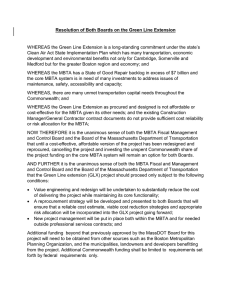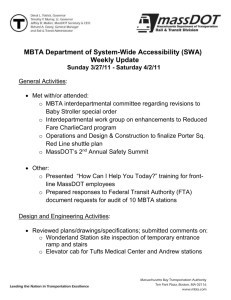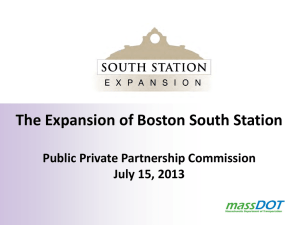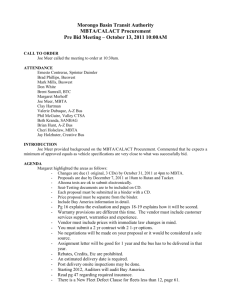APPENDIX E: Summary of MBTA Design and Construction Processes
advertisement
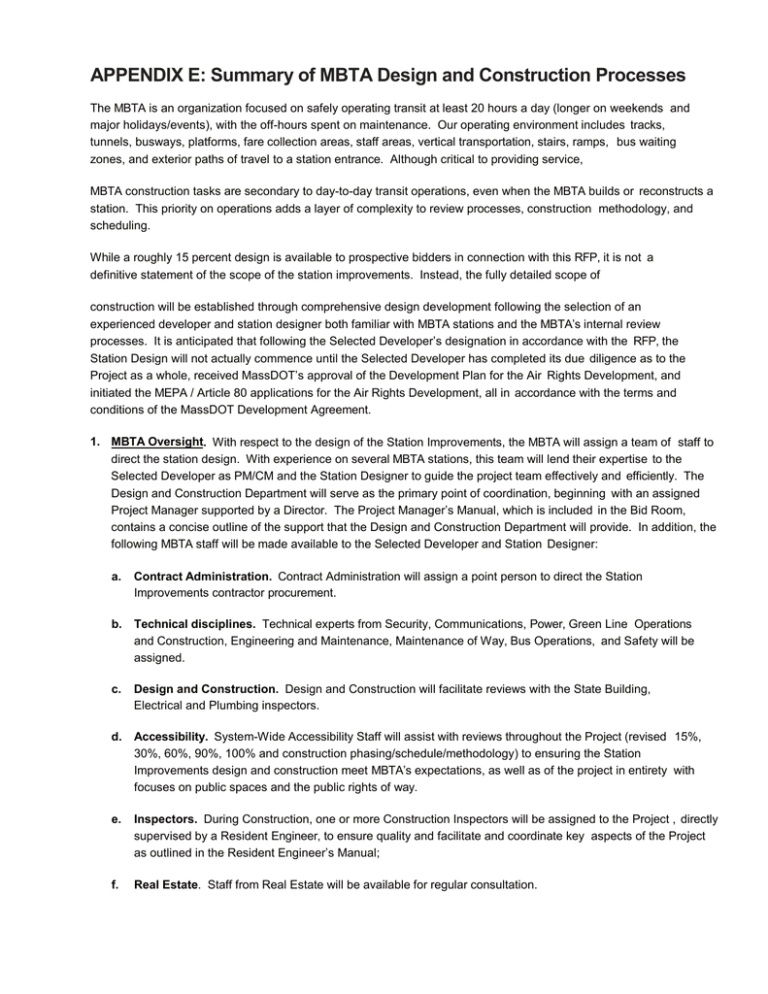
APPENDIX E: Summary of MBTA Design and Construction Processes The MBTA is an organization focused on safely operating transit at least 20 hours a day (longer on weekends and major holidays/events), with the off-hours spent on maintenance. Our operating environment includes tracks, tunnels, busways, platforms, fare collection areas, staff areas, vertical transportation, stairs, ramps, bus waiting zones, and exterior paths of travel to a station entrance. Although critical to providing service, MBTA construction tasks are secondary to day-to-day transit operations, even when the MBTA builds or reconstructs a station. This priority on operations adds a layer of complexity to review processes, construction methodology, and scheduling. While a roughly 15 percent design is available to prospective bidders in connection with this RFP, it is not a definitive statement of the scope of the station improvements. Instead, the fully detailed scope of construction will be established through comprehensive design development following the selection of an experienced developer and station designer both familiar with MBTA stations and the MBTA’s internal review processes. It is anticipated that following the Selected Developer’s designation in accordance with the RFP, the Station Design will not actually commence until the Selected Developer has completed its due diligence as to the Project as a whole, received MassDOT’s approval of the Development Plan for the Air Rights Development, and initiated the MEPA / Article 80 applications for the Air Rights Development, all in accordance with the terms and conditions of the MassDOT Development Agreement. 1. MBTA Oversight. With respect to the design of the Station Improvements, the MBTA will assign a team of staff to direct the station design. With experience on several MBTA stations, this team will lend their expertise to the Selected Developer as PM/CM and the Station Designer to guide the project team effectively and efficiently. The Design and Construction Department will serve as the primary point of coordination, beginning with an assigned Project Manager supported by a Director. The Project Manager’s Manual, which is included in the Bid Room, contains a concise outline of the support that the Design and Construction Department will provide. In addition, the following MBTA staff will be made available to the Selected Developer and Station Designer: a. Contract Administration. Contract Administration will assign a point person to direct the Station Improvements contractor procurement. b. Technical disciplines. Technical experts from Security, Communications, Power, Green Line Operations and Construction, Engineering and Maintenance, Maintenance of Way, Bus Operations, and Safety will be assigned. c. Design and Construction. Design and Construction will facilitate reviews with the State Building, Electrical and Plumbing inspectors. d. Accessibility. System-Wide Accessibility Staff will assist with reviews throughout the Project (revised 15%, 30%, 60%, 90%, 100% and construction phasing/schedule/methodology) to ensuring the Station Improvements design and construction meet MBTA’s expectations, as well as of the project in entirety with focuses on public spaces and the public rights of way. e. Inspectors. During Construction, one or more Construction Inspectors will be assigned to the Project , directly supervised by a Resident Engineer, to ensure quality and facilitate and coordinate key aspects of the Project as outlined in the Resident Engineer’s Manual; f. Real Estate. Staff from Real Estate will be available for regular consultation. g. Wayfinding. MBTA Wayfinding will collaborate with designers to locate and message signs, design all MBTA signs and deliver the art for production and installation throughout the construction period. MBTA’s Design and Construction Department will regularly convene review meetings with the Selected Developer’s team including the Station Designer on technical themes (structures, power, fire systems, etc.) while also staging large-group, interdepartmental reviews at key design milestones (15, 30, 60, 90, and 100 percent, as well as construction phasing/schedule/methodology). As with any complex project, regular meetings and outreach to all MBTA stakeholders will be essential to this Project’s success. Specifically, Design and Construction will require the Selected Developer, Station Designer and/or the Station Contractor to prepare and submit for approval a project management plan, a construction management plan, and a quality assurance plan, among others. These Project Controls procedures are ones followed for all MBTA projects and will be followed for this one as well. Monthly review of cost-loaded schedules will be required for tracking design and construction progress and be linked to invoicing. MBTA’s practices applied to the design process will include risk analysis, constructability review, detailed phasing of work to maintain operations, cost review, and independent structural review. As the MBTA is funded by public money, there will be detailed reporting and auditing requirements for file keeping and financial management. Further, station elements addressing accessibility are a matter of policy for the MBTA, and a 2006 agreement with plaintiffs represented by the Boston Center for Independent Living (“BCIL”) guides that policy. Requirements can exceed applicable code. MBTA’s System-Wide Accessibility department is the day-to-day oversight and guidance on accessibility, and the BCIL plaintiffs remain involved in periodic project reviews. 2. Coordination with MBTA Operations. Construction activities will likely need to be planned around maintaining safe operations of the existing station, and maintaining the safety of all personnel – CM/PM, designers, contractors and MBTA staff – at all times. All personnel involved in compensated work inside of fare collection must attend eight hours of Right of Way safety training and maintain a current certification with bi-annual, fourhour updates. Phasing scenarios will likely involve strategies to maintain space for operations and passengers within the station while under construction, such as closing a half platform at a time, or creating small work zones isolated by physical barriers to ensure no impact to customers and track. To provide Service Agents, Diversion Busing, Paratransit, and Notifications for customers during any impact to service requires a high level of advanced planning and coordination between the Selected Developer’s team and the MBTA with assistance and direction from its Public Relations Department. Flagging will be an important component of the MBTA presence on the work site, as will work performed by MBTA staff for power needs, construction inspection, and other onsite MBTA work.
